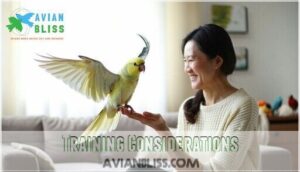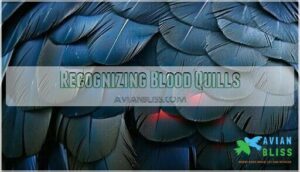This site is supported by our readers. We may earn a commission, at no cost to you, if you purchase through links.
 Wing clipping your bird’s feathers requires proper timing and technique to keep your pet safe.
Wing clipping your bird’s feathers requires proper timing and technique to keep your pet safe.
You’ll need to clip both wings symmetrically every 6-8 weeks, or when new flight feathers grow back.
Always check for blood feathers first – these pink, developing quills can cause serious bleeding if cut.
Young birds need different timing than adults, and newly adopted birds require careful observation before their first clip.
The feathers will regrow completely, so your bird can fly again once you stop clipping.
Getting the technique wrong turns a simple grooming task into a potential emergency room visit for both you and your feathered friend, which is why technique is crucial.
Table Of Contents
- Key Takeaways
- How Often Should You Clip Your Bird’s Wings?
- Can a Bird With Clipped Wings Ever Fly Again?
- Do You Clip One or Both Wings?
- Check for Blood Feathers
- Frequently Asked Questions (FAQs)
- Do most bird owners clip their wings?
- How to correctly clip a bird’s wing?
- How often should you clip your bird’s wings?
- Can a bird with clipped wings ever fly again?
- Is it easier to train a bird with clipped wings?
- Do you clip one or both wings?
- Does wing clipping affect a birds balance?
- Can clipped wings impact a birds mood?
- At what age should you start clipping wings?
- Are there alternatives to wing clipping for safety?
- Conclusion
Key Takeaways
- Check for blood feathers first – You’ll need to identify dark, pin-like quills with bluish bases before cutting, since these contain active blood vessels and will cause serious bleeding if trimmed.
- Always clip both wings symmetrically – You should trim the same number of primary feathers (5-7) on each wing to maintain your bird’s balance and prevent dangerous crashes during flight attempts.
- Schedule clipping every 6-8 weeks – You’ll need regular trimming sessions as new feathers regrow during natural molting cycles, though timing varies based on your bird’s individual growth rate.
- Wait until proper age for young birds – You should let birds reach 8-12 weeks old and gain flight experience before their first clip, allowing proper wing development and coordination skills to form.
How Often Should You Clip Your Bird’s Wings?
You’ll need to clip your bird’s wings every 1-3 months as new feathers grow back during their natural molting cycle.
The exact timing depends on your bird’s individual growth rate and how quickly they regain full flight ability, which can be influenced by their individual growth rate.
Seasonal Timing
Plan your summer trim around post-breeding molt when new feathers emerge naturally.
This seasonal timing prevents stress and aligns with your bird’s molting cycle.
Winter regrowth provides essential insulation during colder months when birds spend more time indoors.
Schedule regular feather checks during spring and fall molting impact periods.
Your clipping schedule should follow these natural patterns rather than arbitrary dates.
Consideration for Young Birds
When dealing with young birds, wing clipping requires patience and careful timing.
Proper wing development is essential before any trimming begins.
Here’s what you need to know:
- Wait until 8-12 weeks of age when feathers fully mature
- Allow early flight experience to develop balance and coordination skills
- Start with gradual trimming while closely observing their flight abilities
Young birds need time to master landing techniques and build confidence through natural flight practice.
Improper clipping can lead to increased risk of falls due to improper clipping.
Observation for New Birds
Before clipping a new bird’s wings, take time for proper Initial Assessment. Watch your feathered friend’s Flight Habits and Personality Factors during the first few weeks.
This observation period reveals vital information about Wing Development and environmental interaction.
| Observation Area | What to Watch | Timeline |
|---|---|---|
| Flight patterns | Control, landing ability | 2-3 weeks |
| Personality traits | Confidence, stress levels | 1-2 weeks |
| Environmental response | Navigation, obstacle avoidance | 2-4 weeks |
Smart personality observation helps you make informed decisions about Gradual Trimming and adjustments in behavior management for your new companion.
Can a Bird With Clipped Wings Ever Fly Again?
Yes, birds with clipped wings can fly again once their feathers regrow during molting periods.
Most birds regain full flight capability within 6 to 12 months after clipping, though you’ll need to retrain them for safe indoor flying habits.
Regrowth Period
Yes, your bird will fly again once those clipped feathers regrow during the natural molting process.
The feather growth cycle varies by species, but most birds achieve full regrowth within 6-12 months.
Several factors affect regrowth speed and feather condition.
- Molting Impact: Seasonal molts trigger complete feather replacement cycles naturally
- Regrowth Speed: Younger birds typically show faster natural regrowth than older ones
- Feather Condition: Previous clipping history can influence new feather strength and quality
Training Considerations
Several smart steps can jumpstart your bird’s return to flight. Start recall training with positive reinforcement techniques that build trust and confidence.
Create a safe environment for practice sessions, keeping windows closed and removing hazards. Expect behavioral changes as your bird adjusts—some may feel uncertain at first.
Be aware that wing clipping can lead to increased anxiety and stress. Schedule flight training sessions 2-3 times weekly, gradually increasing challenges.
Consider expert consultation for personalized guidance, especially if you notice unusual behaviors during recovery.
Do You Clip One or Both Wings?
You should always clip both wings symmetrically to maintain your bird’s balance and prevent dangerous crashes.
Balanced wings mean safe landings—never clip just one side.
Trimming just one wing creates uneven flight that can lead to serious injuries when your bird attempts to fly.
Symmetric Clipping Technique
Once your bird’s wings are clipped, they won’t be flight-free forever. Now comes the critical part: maintaining proper Balance Maintenance through symmetric clipping. You’ll want to trim both wings equally to maintain your bird’s flight balance during controlled descents.
Here’s your wing clipping guide for safe symmetric clipping:
- Trim the same Feather Count on each wing (typically 5-7 primary feathers)
- Use Conservative Trimming techniques to avoid over-clipping
- Maintain symmetry between primary and secondary wing feathers positioning
- Focus on creating predictable Flight Patterns for safe landings
Professional wing clipping techniques guarantee your bird glides gracefully rather than crashes awkwardly. This Injury Prevention approach keeps your feathered friend safe while maintaining their dignity during descent. Clipping can also lead to increased injury risk if not done correctly.
Flight Control Considerations
When you maintain symmetrical clipping impact, your bird retains better flight control and safer controlled descent abilities.
This approach prevents dangerous crashes while preserving some flight ability retention. Wing length affects maneuverability during landings, so trim conservatively at first.
Consider how covert feathers influence feather regrowth patterns. Your owner skill level matters—consult an avian veterinarian for proper technique using recommended scissors.
The goal isn’t preventing bird flight entirely but managing it safely. Monitor behavior changes closely after clipping to guarantee bird welfare remains superior throughout the process.
Check for Blood Feathers
Before you start clipping, you must identify blood feathers to avoid causing pain and bleeding.
These dark, pin-like quills have a bluish base and contain active blood vessels that make them off-limits for trimming.
Blood feathers are growing quills with active blood supply – never cut these dark, pin-like feathers during wing clipping.
Recognizing Blood Quills
Every single blood feather poses a serious risk during wing clipping.
These immature blood quills appear dark and pin-like with bluish bases, containing active blood vessels.
Quill identification becomes your first line of defense for injury prevention.
You can’t afford to cut these growing feathers – it causes bleeding and pain.
Clipping safety depends on recognizing feather development stages.
Test your bird’s flight abilities to gauge feather maturity.
Only trim fully developed primary feathers.
Blood feathering occurs during active growth stage periods.
Sharp identification skills protect your feathered friend from unnecessary harm.
You may want to keep blood clotting products nearby in case of accidents.
Precautions During Clipping
Before clipping your bird’s wings, you’ll need proper preparation for injury prevention.
Creating a calm environment with good lighting helps you spot dangerous blood feathers easily.
Safe restraint using a soft towel protects both you and your bird during the process.
A broken blood feather can lead to severe bleeding incidents, so immediate action is vital.
- Check feather maturity – avoid dark, blood-filled quills that can cause serious bleeding
- Use proper tools – sharp, sterilized scissors prevent crushing and infection risks
- Prepare styptic powder – stops bleeding immediately if improper technique causes cuts
Post-clip monitoring guarantees safe wing clipping success.
Frequently Asked Questions (FAQs)
Do most bird owners clip their wings?
Most owners don’t routinely "trim their feathered friends’ wings" anymore. You’ll find practices vary widely – some clip regularly for safety, others never clip, preferring training and bird-proofed homes instead.
How to correctly clip a bird’s wing?
Use sharp scissors to trim 5-7 primary flight feathers per wing in a quiet room.
Wrap your bird gently in a towel, avoid blood feathers, and cut halfway down each feather shaft symmetrically.
How often should you clip your bird’s wings?
How much is too much in the context of feather maintenance?
You’ll need to clip your bird’s wings every 1-3 months as feathers regrow after molting.
Monitor flight ability regularly and adjust timing based on your bird’s growth rate.
Can a bird with clipped wings ever fly again?
Yes, your bird can fly again!
Wing clipping only removes mature feathers temporarily.
During molting cycles, which happen every 6-12 months, new flight feathers grow back completely, restoring full flying ability.
Is it easier to train a bird with clipped wings?
Like removing training wheels from a bike, clipping your bird’s wings can make training easier.
Clipped birds often become more manageable and less likely to escape during sessions, helping rookie owners build trust.
Do you clip one or both wings?
You should clip both wings symmetrically. Clipping just one wing creates an unbalanced bird that’ll spiral or crash when attempting flight, potentially causing injury.
Does wing clipping affect a birds balance?
Think of your bird’s wings as airplane wings – trim them unevenly and you’ll get a crash landing.
Symmetric wing clipping maintains balance, while one-sided clipping causes dangerous tilting and awkward crashes.
Can clipped wings impact a birds mood?
Clipped wings can definitely impact your bird’s mood and behavior.
You’ll likely notice changes in activity levels, exploration habits, and overall confidence.
Some birds become more docile while others may show signs of stress or frustration.
At what age should you start clipping wings?
Wait until your bird reaches 8-12 weeks old before you start clipping wings. This timing allows proper wing development while ensuring your bird learns basic flight skills before restricting movement.
Are there alternatives to wing clipping for safety?
Yes, you can create safe environments through bird-proofing rooms, harness training, supervised free-flight sessions, positive reinforcement training, and recall commands instead of clipping wings.
Conclusion
Remember the saying "measure twice, cut once" – this wing clipping guide for bird owners emphasizes preparation over speed.
You’ve learned the essential timing, safety checks, and techniques needed for successful wing clipping.
Always inspect for blood feathers before cutting, maintain symmetrical clipping on both wings, and schedule regular sessions every 6-8 weeks.
With proper technique and patience, you’ll keep your feathered friend safe while maintaining their wellbeing and your peace of mind.








